
Sir Edwin Alliot Verdon Roe (1877 - 1970)
Sir Edwin Alliot Verdon Roe was born in 1877 in Manchester, England. The son of a doctor, he left home when was 14 to Canada where he spent a year working odd jobs. Once he returned to England, he became an apprentice at the Lancashire and Yorkshire Railway Locomotive Works. During this time, he was a winning bicycle racer, a similar hobby of the Wright brothers. Soon he became bored and got another job in a boat yard. This led him to London University where he earned a degree in Marine Engineering.
Upon returning to London in 1907, one of Roe,s models won a 75 pound prize from the Daily Mail newspaper which often featured airplane model contests. He used this money to build a full sized biplane which he finished and tested at the Brooklands in September of 1907. The owner of the land was not very hospitable, and forced Roe to live in the hangar and spend only 5 shillings a week for food. His design endured many crashes, but its first hop airborn was on June 8, 1908. This could be considered the first flight in London, but was never officially recognized. He than began construction of a triplane, which never was finished and was auctioned off for financial reasons. In 1909 he completed another triplane which was completed under a railway arch, which served as his home as well. Roe was so impoverished that he covered the wings in packing paper since cloth was too expensive. This design flew well, and he steadily built more reliable aircraft and soon founded the A.V. Roe Aircraft Co. in 1910. His most popular model, the 504, sold more than 8,300. In 1928, he sold his shares and bought S.E. Saunder,s Co. and formed SARO Aviation. Roe died in 1970, one of the few men lucky enough to witness first hand the birth of aviation and its evolution to spaceflight.
Alliott Verdon Roe Alliott Verdon Roe was born in 1877 in Patricroft, Manchester. His father was a Doctor and his mother was later famous for her work in organising and setting standards for day nurseries. His father had hoped that his son would follow in his profession but the boy was more keenly interested in engineering. When he was fourteen he set off to Canada to work in a civil engineering firm, but the job did not last long. The young Alliott then engaged in an apprenticeship in Portsmouth dockyard which he duly completed. After studying marine engineering at Kings College, London as well as the dockyard the young man joined the ship S.S.Inchanga as fifth engineer. It was during this time that Alliott first turned his mind to the possibility of actually building a flying machine. He began with small models and in this he was quite successful. When the Wright brothers made the very first flight in a heavier than air machine at Kittyhawk, U.S.A. he was almost immediately in correspondence with them. He applied for and took a job with the Royal Aero Club. Then found a job in the U.S.A. with a firm trying to build a gyrocopter. The machine was a failure and Alliott was back in Britain. But not discouraged. It was in 1906 that he patented the first aircraft control column, as previously two levers were required. It was as well he patented the idea as many years later a Frenchman tried to claim copyright and £1,000,000 damages. When Lord Northcliffe of the Daily Mail offered a prize of £250 for a model capable of sustained flight Alliott took the prize. Thus encouraged he designed and built his own real aircraft. He set up shop at Brooklands, near Weybridge. On the 8th June, 1908 A.V. Roe actually flew for the first time, but his short flights were not registered officially by the Royal Aero Club and Lord Brabazon took the honour of registering first. Roe pressed on regardless. It was a challenging time as he had to learn so much. Designing, building and flying all at once! It was dangerous because things kept breaking. Controls were not correctly understood and engines were unreliable. On the plus side the aircraft of those days could glide and crashes were often not fatal. After being evicted from Brooklands, and then Hackney Marshes Alliott Roe set up his flying operations at Wembley Park, Middlesex, as it then was. Alliott's brother, Humphrey, who was later to marry Marie Stoppes, came into the business and on New Years Day 1910 A.V. Roe became the first company ever to be registered as an airplane manufacturer.. The learning curve was so fast, that hardly ever were two aircraft built that were exactly the same. Improvements came along at a breathtaking pace. Manufacturing moved to Manchester and with Brooklands under new management an AVRO flying school was set up there, later moving to Shoreham. Other money-earning ventures were the founding of an aircraft spares warehouse and the invention and marketing of a turnbuckle for tightening the bracing wires used on aircraft in those days. With the coming of the First World War, A.V. Roe and Co. had a first rate aircraft for the forces. It was the AVRO 504. A good basic design that leant itself to a variety of engines. So good was it that it became a standard trainer after the war and soldiered on until 1940 during the Second World War....more
A History of Aeronautics
XIII. First Fliers in England Another figure of the early days was A.V. Roe, who came from marine engineering to the motor industry and aviation in 1905. In 1906 he went out to Colorado, getting out drawings for the Davidson helicopter, and in 1907 having returned to England, he obtained highest award out of 200 entries in a model aeroplane flying competition. From the design of this model he built a full-sized machine, and made a first flight on it, fitted with a 24 horse-power Antoinette engine, in June of 1908 Later, he fitted a 9 horsepower motor-cycle engine to a triplane of his own design, and with this made a number of short flights; he got his flying brevet on a triplane with a motor of 35 horse-power, which, together with a second triplane, was entered for the Blackpool aviation meeting of 1910 but was burnt in transport to the meeting. He was responsible for the building of the first seaplane to rise from English waters, and may be counted the pioneer of the tractor type of biplane. In 1913 he built a two-seater tractor biplane with 80 horse-power engine, a machine which for some considerable time ranked as a leader of design. Together with E. V. Roe and H. V. Roe, 'A. V.' controlled the AVRO works, which produced some of the most famous training machines of the war period in a modification of the original 80 horse-power tractor. The first of the series of AVRO tractors to be adopted by the military authorities was the 1912 biplane, a two-seater fitted with 50 horsepower engine. It was the first tractor biplane with a closed fuselage to be used for military work, and became standard for the type. The AVRO seaplane, of I 100 horse-power (a fourteen-cylinder Gnome engine was used) was taken up by the British Admiralty in 1913. It had a length of 34 feet and a wing-span of 50 feet, and was of the twin-float type. Geoffrey de Havilland, though of later rank, counts high among designers of British machines. He qualified for his brevet as late as February, 1911, on a biplane of his own construction, and became responsible for the design of the BE2, the first successful British Government biplane. On this he made a British height record of 10,500 feet over Salisbury Plain, in August of 1912, when he took up Major Sykes as passenger. In the war period he was one of the principal designers of fighting and reconnaissance machines.
Roe, Alliot Verdon English aircraft designer, the first Briton to construct and fly an aeroplane, in 1908. He designed the AVRO series of aircraft from 1912. Roe was born in Patricroft, near Manchester, was apprenticed to a railway company, then entered the motor industry. He became interested in aircraft design, and his biplane flew a distance of 23 m/75 ft nearly a year before the first officially recognized flight in England by John Moore-Brabazon (1884-1964). In 1910 Roe founded the firm of A V Roe and Company, manufacturing aircraft, but in 1928 he left the firm and turned his attention to the design of flying boats. He founded the Saunders-Roe Company based on the Isle of Wight. The first aircraft from the Manchester works was the AVRO 500, one of the first machines to be ordered for use by the British army. Two of these formed the strength of the Central Flying School of the Royal Flying Corps. In 1913 the company produced its first seaplane, a large biplane known as the AVRO 503. The AVRO 504, also 1913, was considerably in advance of its contemporaries, and would be used for decades of safe flying instruction. Although not basically a military aircraft, it was used extensively in World War I. Many modifications followed; the 504H was the first aircraft to be successfully launched by catapult.
Sir Edwin Alliot Verdon Roe Born in Patricroft in Manchester in 1877, Sir Edwin Alliot Verdon Roe was to become a most celebrated aircraft designer. He served as an apprentice with the Lancashire and Yorkshire Railways and later went to study marine engineering at King's College, London. In 1899 he worked for the British & South African Royal Mail Company as an engineer. Gradually he developed an interest in birds and in flight, and began to construct flying models, winning a prize of £75 for one of his designs in 1907, against fierce competition. With the prize money he built a full size aeroplane based on his winning model. He attempted a test flight at Brooklands, but unfortunately it would not lift off. In 1908, fitted with a more powerful engine, he succeeded in getting the plane airborne and making several short flights - the first British built plane to fly under its own power. With the help of his brother, Edwin founded the AVRO company (based on his own name and initials) in Manchester in 1910, and set up the AVRO Company in Oldham, before going on to design another aircraft with an enclosed cabin, which went on to establish a British flying record of 7 hours and 30 minutes. Upon this achievement he went on to build the famous AVRO 504 biplane in 1913, which was to serve as the most commonly used military aircraft in World War One, and its design was to be copied by others all over the world. The Armstrong Siddeley Company took over AVRO in 1928, Roe having sold his interest in the company, to move into boat design with the Saunders Company at Cowes in the Isle of Wight. The result of this move was, predictably, the invention of the flying boat, for which Roe was knighted in 1929. Throughout his life, Roe's love of and interest in flying and aircraft continued, despite losing 2 of his sons in fighter planes during the Second World War.
Roe, Alliot Verdon English aircraft designer, the first Briton to construct and fly an aeroplane, in 1908. He designed the AVRO series of aircraft from 1912. Roe was born in Patricroft, near Manchester, was apprenticed to a railway company, then entered the motor industry. He became interested in aircraft design, and his biplane flew a distance of 23 m/75 ft nearly a year before the first officially recognized flight in England by John Moore-Brabazon (1884-1964). In 1910 Roe founded the firm of A V Roe and Company, manufacturing aircraft, but in 1928 he left the firm and turned his attention to the design of flying boats. He founded the Saunders-Roe Company based on the Isle of Wight. The first aircraft from the Manchester works was the AVRO 500, one of the first machines to be ordered for use by the British army. Two of these formed the strength of the Central Flying School of the Royal Flying Corps. In 1913 the company produced its first seaplane, a large biplane known as the AVRO 503. The AVRO 504, also 1913, was considerably in advance of its contemporaries, and would be used for decades of safe flying instruction. Although not basically a military aircraft, it was used extensively in World War I. Many modifications followed; the 504H was the first aircraft to be successfully launched by catapult.
History of Flight : Alliot Verdon Roe In 1907, Alliot Verdon Roe entered a contest organised by the Daily Mail and built three models which he flew at the Agricultural Hall in March 1907 to capture the premier honours from over 200 contestants. With the £75 which he won he set about constructing his first full sized aircraft. Roe obtained permission to build a shed at Brooklands where the motor racing authorities offered a prize of £2,500 to the first aviator to fly around the track before the end of 1907. His first machine was fitted with a 9hp J.A.P engine with which he made a number of towed hops but there was insufficient power to enable the craft to rise unaided. According to his book The World of Wings and Things A.V.Roe records that on the 8th June his aircraft left the ground under its own power aided with a new 24hp Antoinette engine from France albeit the time had expired for the prize offered. In 1908, Roe, encouraged by the Wright brothers flight constructed his own full sized aircraft based on the most succesful of his models which were inspired by the flight of Albatrosses that he observed on his travels overseas. In 1910, Roe and Reginald J. Parrot commenced an association which led to the formation of the company A.V.Roe & co which was registered on the 1st of January, 1910 and used the basement of Humphrey Verdon Roe's Mill on Great Ancoats Street Manchester as a workshop. In June 1910, A young mechanic, Howard Pixton joined Roe working without pay for the privilage of having flying lessons which gained him Aero club Certificate No 50 on 24th January 1911 and subsequently winning the 1913 Schneider Tropy race. In 1911, throughout the year both the flying training and manufacturing sides of A.V.Roe & co continued to develop. The flying school at Brooklands and The Aviator's storehouse at Brownsfield Mill became succesful with many trainees becoming famous as pilots and many designs of aircraft such as a Farman type biplane and a Curtis type aircraft being built. In 1912, the worlds first aircraft with a totally enclosed cabin, the type F was flown by Lieutenant Wilfrid Parke and reached 1,000 ft using a 35hp Viale engine. In June 1912, The 3rd Central Flying school aircraft which was a new design known as the AVRO 500 and powered by a 50hp Gnome engine was taken to Eccles Cricket ground and tested by Lieutenant Parke. In 1913, Additional finance from the Groves family of Manchester Brewers enabled the transfer of the works to new premises in Clifton Street, Miles Platting where staff included a brilliant young draughtsman named Roy Chadwick who was to achieve undying fame as the designer of the Lancaster and many other aircraft. On the 21st of November 1914, possibly the first air raid by powered aircrcraft. Four AVRO 504's powered by 80hp Gnome engines were assembled at Manchester Aerodrome and along with two pilots and eleven air mechanics formed a squadron. After being transported to Belfort in Eastern France the aircraft were, on the morning of 21st November, each fitted with 4x20 lb bombs and prepared for the 125 miles round trip. Three aircraft took off successfully but No 179 failed to become airborne. After crossing the Black forest mountains they attacked an airship base damaging a Zeppelin works and setting a gasworks on fire. Flight Commander J.T.Babington and Flight Lieutenant S.V.Sippe returned safely but Squadron Commander E.F.Briggs was shot down and captured only to escape from enemy hands subsequently commanding the experimental station at Eastchurch. In 1928, Roe and John Lord sell out their interest in A.V.Roe and together took over the firm of S.E.Saunders Ltd and formed Saunders-Roe Ltd.
Sir Alliott Verdon Roe Sir Alliott Verdon Roe (Born Patricroft, England April 27, 1877 - d. January 4, 1958) entered into the design of airplanes in 1907 through the development of flying model planes and the development of his designs to full size machines. In 1908 he became one of the first in Great Britain to fly a powered aircraft. His struggle against adversity and ridicule was overcome through his undefeatable optimism. Progressing from short flights in delicate and under-powered machines, he became a leading producer of combat aircraft in World War I, and the managing director of a premier British aircraft manufacturing company. The great AVRO Company, which bore his name, was incorporated in 1910. Today it continues in the traditions he established as the Manchester Division of British Aerospace. Among his advanced concepts and innovations were the world's first enclosed cabin aircraft, the first British hydroplane, and the combining of separate flight controls into a single steering column. Although initially plagued by the adversities of fire, shortage of capital, and inadequate engines, his perseverance prevailed and the AVRO trademark was to be seen throughout the Empire on civil and military aircraft of every type. None was more famed and of greater impact than the rugged training plane of the First World War, the Model 504, which served Britain and the Allies so valiantly. A distinguished aviation career of 45 years was most appropriately recognized in 1929 when a grateful Government conferred knighthood upon him for service to aviation.
The Mastery of The Air The honour of being the first man to fly in this country is claimed by Mr. A. V. Roe, head of the well-known firm A. V. Roe & Co., of Manchester, and constructor of the highly-efficient Avro machines. As a youth Roe's great hobby was the construction of toy models of various forms of machinery, and later on he achieved considerable success in the production of aeroplane models. All manner of novelties were the outcome of his fertile brain, and as it has been truly remarked, "his novelties have the peculiarity, not granted to most pioneers, of being in one respect or another ahead of his contemporaries." In addition, he studied the flight of birds. In the early days of aviation Mr. Roe was a firm believer in the triplane form of machine, and his first experiments in flight were made with a triplane equipped with an engine which developed only 9 horse-power. Later on, he turned his attention to the biplane, and with this craft he has been highly successful. The Avro biplane, produced in 1913, was one of the very best machines which appeared in that eventful year. The Daily Telegraph, when relating its performances, said:
"The spectators at Hendon were given a remarkable demonstration of the wonderful qualities of this fine Avro biplane, whose splendid performances stamped it as one of the finest aeroplanes ever designed, if not indeed the finest of all".This craft is fitted with an 80-horse-power Gnome engine, and is probably the fastest passenger-carrying biplane of its type in the world. Its total weight, with engine, fuel for three hours, and a passenger, is 1550 pounds, and it has a main-plane surface of 342 square feet. Not only can the biplane maintain such great speed, but, what is of great importance for observation purposes, it can fly at the slow rate of 30 miles per hour. We have previously remarked that a machine is kept up in the air by the speed it attains; if its normal flying speed be much reduced the machine drops to earth unless the rate of flying is accelerated by diving, or other means. What Harry Hawker is to Mr. Sopwith so is F. P. Raynham to Mr. Roe. This skilful pilot learned to fly at Brooklands, and during the last year or two he has been continuously engaged in testing Avro machines, and passing them through the Army reception trials. In the "Aerial Derby" of 1913 Mr. Raynham piloted an 80-horse-power Avro biplane, and came in fourth.
The Aircraft
A young British marine engineer, A. V. Roe, started aeronautical experiments in 1906. By 1907 he had constructed a machine which made short hops but was not a successful flyer. Early in 1909 he completed a small triplane powered with a 9 h.p. J. A. P. motor driving a tractor propeller. Heavy paper was used for covering the wings of this airplane. In it Roe made several straightaway flights. He then redesigned the machine, and the 1910 version with a 35 h. p. Green engine, flew quite well. Roe flew this machine in the Blackpool meet of that year. The next Roe design was a biplane with a 35 h.p. Green engine. It performed nicely and even carried a passenger. This staunch little ship was the first to hear the now famous trade-name "AVRO." Among the many design innovations introduced by AVRO were a cabin monoplane and biplane built in 1912. (Charles H. Hubbell)
FlightDeck Milestones : AVRO 504 The original AVRO 504 had been designed in 1913 by Sir Alliot Verdon Roe, and entered the British Royal Flying Corps as a standard Service machine. The aircraft had a top speed of 82 mph. (132 km/h), could climb to 10,000 feet in 19 minutes and could stay aloft for three hours. Early in the war the 504 strafed the enemy and bombed the zeppelin sheds at Freidrichshafen, but it soon became clear it wasn't destined to compete with the faster, meaner planes then being rolled out, such as the Fokker E.III. Because of its ability to operate at the "extreme height" of 13,000 ft (3960 m) it was relegated to the role of anti-zeppelin patrol plane. It did, however, make an admirable trainer airplane and was developed in this way by Major R.R. Smith-Barry, along with his personal instruction method. In this incarnation it made a significant impact all over the world, and laid the foundations for formal flyer training that would last another 30 years. Ultimately, the AVRO 504 was built in Australia, Belgium, Canada, Japan and the USSR, with production continuing until 1933. Estimates vary as to how many were made, ranging from 6,350 to over 10,000. The advantages that the 504 had over previous trainers were numerous. The Curtiss JN-4, envisaged as a trainer, was difficult to fit with a rotary engine. This was seen as vital to familiarize flying students. To deal with this problem the 504K ...was introduced in 1917, and sported a new type of universal engine mount which consisted of two bearer plates that could accommodate any sort of engine. The 504K was variously fitted with the 100 hp Gnome B Monosoupape, the 110 hp Le Rhône 9J, and the 130 hp Clerget 9B engine. Another advantage was the ease with which students and instructors could communicate in the cockpit, thanks to the "Gosport Speaking Tube". It was more robust than the delicate Farman trainer, and more manoueverable than the heavy BE2c. The 504's relatively light weight in comparison to its wing size prevented the plane from dropping dramatically when power was reduced, and the "forgiving" quality of its controls were ideal for training. So too was the skid that could be outfitted under the nose, designed to prevent tipping during landing. The 504 had the distinction of quite a few "firsts". It was the first airplane to strafe troops on the ground, and the first to run a bombing raid over Germany. It also had the dubious honour of being the first Allied airplane to be downed by enemy ground fire. It was the first airplane to run a commercial bush flight in Canada when it ferried two passengers from Winnipeg to Le Pas, Manitoba in 1920, and the first to make a winter flight to James Bay in 1922. The Turnbull variable pitch propeller ...played a great role in the advancement of aviation world-wide, and was a uniquely Canadian invention. It was the handicraft of Wallace Rupert Turnbull of Rothesay, New Brunswick, who had built an early wind tunnel in an abandoned barn near his home. To increase lateral stability Turnbull had early advocated the inclination of each wing tip upward from its center section to its tip, creating the dihedral angle that was to greatly influence later design. His controllable pitch propeller allowed the pilot to control the pitch or angle of the blades at all times during flight, enabling variation in the amount of thrust pushed back over the wings. In particular, this made take-offs much easier, and was used widely around the world.
AVRO 504 One of the most important aircraft in the early RAF. The AVRO 504 began development in late 1912, and first flew in July 1913, and was in service at the start of first world war, serving with both the RFC and the RNAS. The RFC used the 504 for reconnaissance and gun spotting, and rarely had more than one or two of the type with any squadron, and none after mid-1915. The RNAS used the 504 as a strategic bomber early in the war, starting with a raid on the Zeppelin sheds at Friedrichshafen on Lake Constance (21 November 1914), where a lucky strike on the gas plant caused most damage, but later raids did little damage. The true value of the 504 was as a pilot trainer. It's design made it safe to fly, but hard to fly with skill, the ideal balance for a trainer, and from 1916 both the RFC and RNAS used it as their standard training craft. The 504 was adopted in the same role by the RAF, and after the end of the war it's use spread to most commonwealth airforces, as well as Russia and Japan. The last model, the 504N was produced from 1927 until 1933, and during the twenty years of it's manufacture nearly 9,000 were produced, some of which were still in use at the start of the second world war.
Gallery
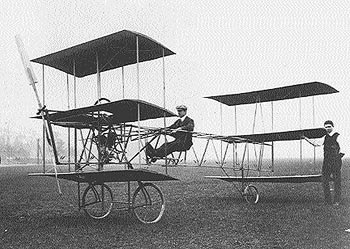 AVRO Triplane 1, 9hp JAP, 1909 http://www.sciencemuseum.org.uk
 AVRO Triplane 1, 24hp. Antoinette, Wembley, 1909
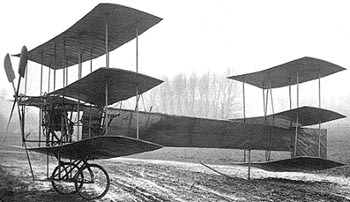 AVRO Triplane 1, 24hp. Antoinette, Wembley, 1909
 AVRO Triplane 1, 1909
 AVRO Triplane 3, 1910
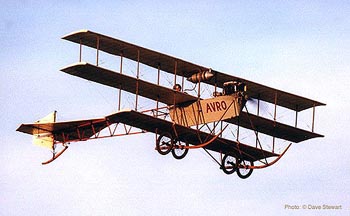 AVRO Triplane 4, 1910 Dave Stewart download a 750pixel image
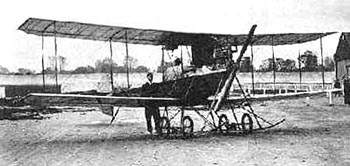 AVRO D, 1911
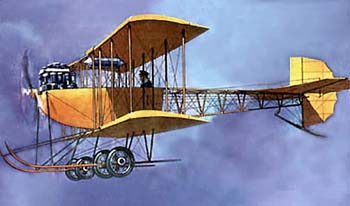
AVRO D, 1911 download a 500 pixel image
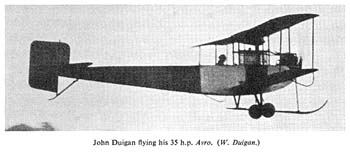 John R. Duigan flying the AVRO-Duigan Biplane, 1911 Penrose, Harold. British Aviation : The Pioneer Years 1903-1914,1st Published by Putnam and Revised edition by Cassell, London. download a 500 pixel or 750 pixel image
 A Visit to the AVRO Works The Aeroplane, December 7, 1911, Duigan Family Archives download a 750 pixel or 1000 pixel image
For more information about the AVRO-Duigan (incl. scale plans), visit Derek Buckmaster's Design Bureau website
AVRO E, Two-seat biplane, precursor of the AVRO 500, 1912, Crew: 2, Engine: 45kW E.N.V. Speed: 80km/h
AVRO 500 Development of the AVRO E. 21 built. 1912, Crew: 2, Engine: 33kW Gnome
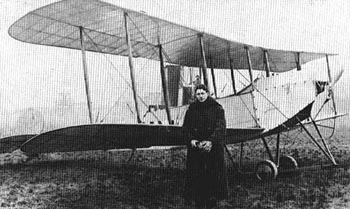 AVRO 500, Lawrence Hall, Hendon, 1913
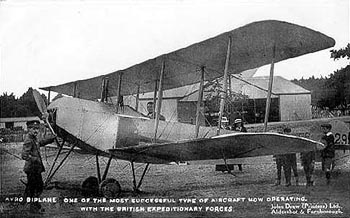 AVRO 500, 1913
AVRO 501 Two-seat biplane. One built. Engine: 75kW Gnome
AVRO 503 Two-seat biplane. Four built. Engine: 75kW Gnome
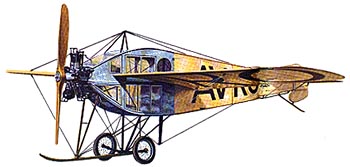 AVRO F, 1912
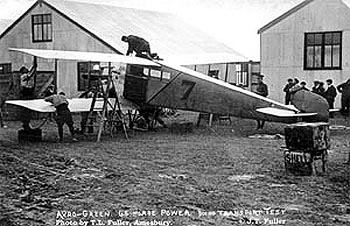 AVRO G at Lark Hill, August 1912
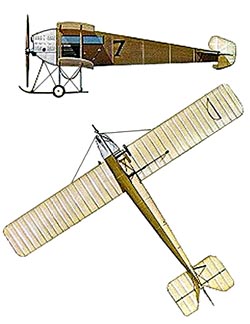 AVRO G, 1912, 2View
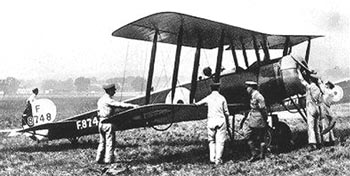 AVRO 504
Standard RAF biplane trainer of WWI, the British equivalent of the Curtiss JN. Also used briefly as fighter and bomber, and postwar by air shows. The 504 was also built in Belgium, Australia, Japan, Canada and the USSR. 8340 were built, with the production continuing until 1933. Type : AVRO 504K, Function: trainer, Year: 1916, Crew: 2, Engine: 110hp Le Rhone, Wing Span: 10.97m, Length: 8.97m, Height: 3.17m, Wing Area: 30.66m2, Empty Weight: 558kg, Max.Weight: 830kg, Speed: 153km/h, Ceiling: 4875m, Range: 402km
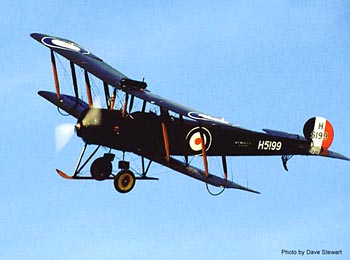 AVRO 504 Dave Stewart
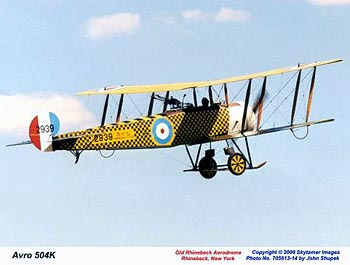 AVRO 504 John Shupeck
AVRO 521 Two-seat fighter, built with a number of AVRO 504 components. One built, an order for 25 was cancelled. Type: 521, Function: fighter, Year: 1916, Crew: 2, Engine: 110hp Clerget 9Z, Wing Span: 9.14m Length: 8.58m, Height: Wing Area: 24.71m2, Empty Weight: 522kg, Max.Weight: 905kg, Speed: 145km/h, Ceiling: Range: 4.5hrs, Armament: 2*mg7.7mm
AVRO 527 Fighter derivative of the AVRO 504. The 527 had a modified fuselage and a liquid-cooled engine. One built. Type: 527, Function: fighter, Year: 1916, Crew: 2, Engine: 150hp Sunbeam Nubian, Wing Span: 10.97m, Length:, Height:, Wing Area:, Empty Weight:, Max.Weight:, Speed: 166km/h, Ceiling:, Range:, Armament: 1*mg7.7mm
AVRO 529 Twin-engined bomber of 1917. No production.
AVRO 530 Two-seat fighter, competing with the Bristol F.2A for orders. The 530 had a deep rectangular fuselage, and a remarkable ducted propeller for the cooling system. Performance was good, but not good enough to justify production, and the engine was in short supply. Two built. Type: 530, Function: fighter, Year: 1917, Crew: 2, Engine: 200hp Hispano-Suiza 8Bd, Wing Span: 10.97m, Length: 8.69m, Height: 2.92m, Wing Area: 30.23m2, Empty Weight: 769kh, Max.Weight: 1216kg, Speed: 183km/h, Ceiling: 18000ft Range: 4hrs, Armament: 2*mg7.7mm
AVRO 531 Spider Biplane fighter. The Spider had a complex arrangement of V-struts, without bracing wires, between the wings. It was a good fighter, but the Sopwith Camel was already in production. Type: Spider, Function: fighter, Year: 1918, Crew: 1, Engine: 130hp Clerget 9B, Wing Span: 8.68m, Length: 6.25m, Height: 2.38m, Wing Area: 17.55m2, Empty Weight: 437kg, Max.Weight: 688kg, Speed: 193km/h, Ceiling: 5970m, Range: 400km, Armament: 1*mg7.7mm
|
© Copyright 1999-2002 CTIE - All Rights Reserved - Caution |
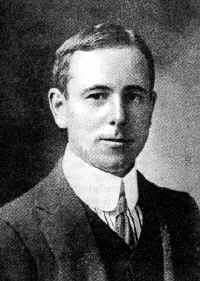 Sir Edwin Alliot Verdon Roe
Sir Edwin Alliot Verdon Roe